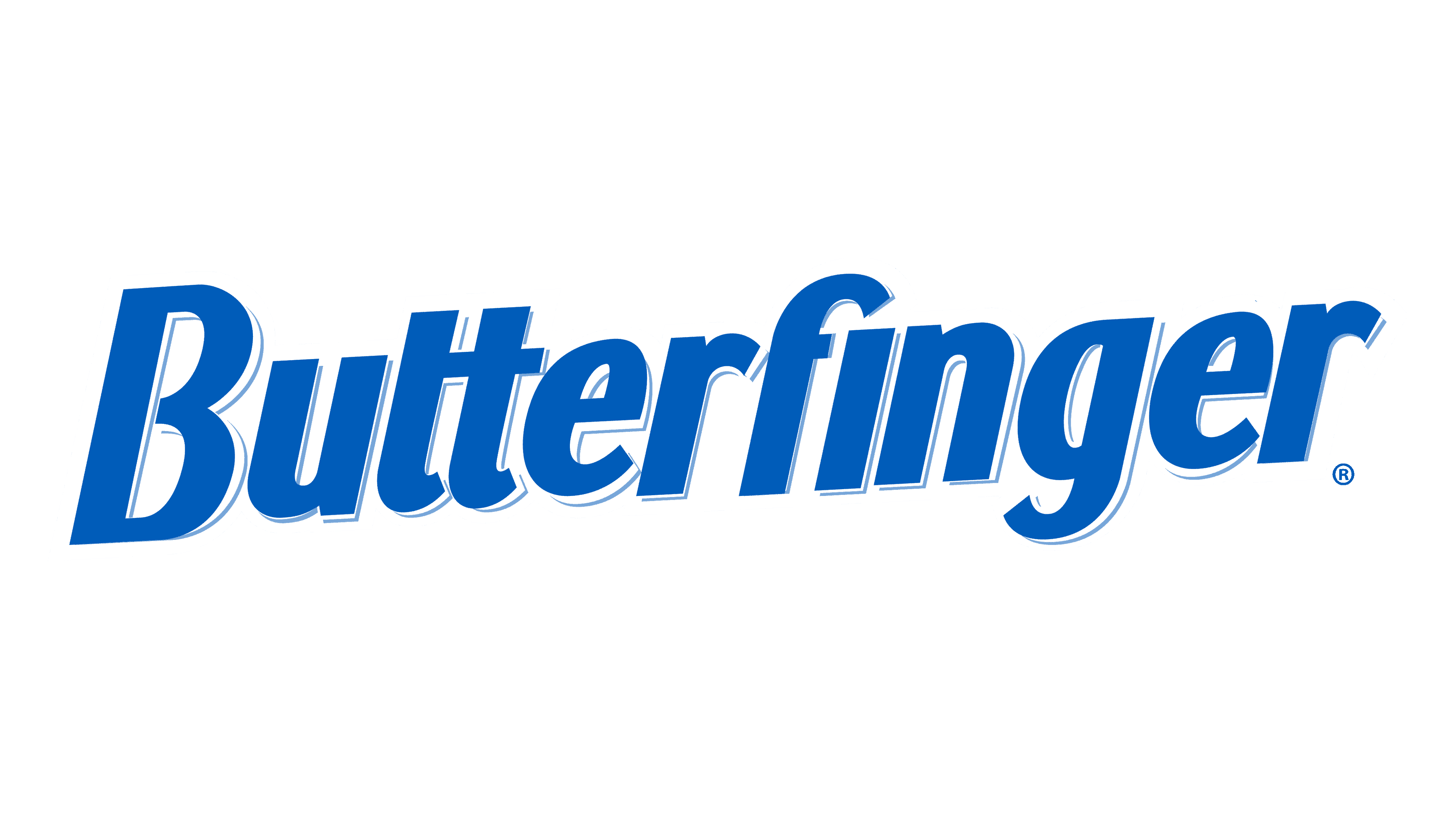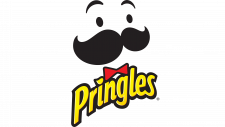Butterfinger Logo
Butterfinger is a popular candy bar known for its crispy peanut butter core and chocolate coating. The Curtiss Candy Company, based in Chicago, originally developed this treat. They aimed to create a unique confectionary item that offered a distinct texture and flavor profile, different from typical chocolate bars.
Meaning and history
Butterfinger, a popular candy bar, was invented in 1923 by the Curtiss Candy Company in Chicago. Its crunchy texture and unique peanut butter flavor quickly captured the public’s attention. To promote it, Curtiss held a public contest to name the new treat, resulting in “Butterfinger”.
In 1964, Standard Brands acquired Curtiss, merging with Nabisco in 1981. This brought Butterfinger under Nabisco’s vast distribution network, enhancing its popularity.
The 1990s were iconic for Butterfinger, largely due to a marketing partnership with “The Simpsons”. Bart Simpson’s catchphrase, “Nobody better lay a finger on my Butterfinger!” became widely recognized.
In 1990, Nestlé bought Butterfinger, introducing innovations like Butterfinger BB’s and Butterfinger Ice Cream Bars. Despite these expansions, the core candy bar remained most loved.
In 2018, Ferrero Group purchased Butterfinger, along with other Nestlé USA confectionery brands. Ferrero revamped the recipe in 2019, promising a higher cocoa and milk content, aiming to improve taste and texture. This reformulation was part of a broader effort to rejuvenate the brand and maintain its legacy in a competitive market.
What is Butterfinger?
Butterfinger is a candy bar that features a flaky, crisp peanut butter center encased in milk chocolate. Its distinctive texture and bold flavor make it a favorite among sweet tooths. The bar is recognized for its bright yellow and blue packaging.
1923 – 1932
The Butterfinger logo appears prominently on a vibrant yellow background, emphasizing its brand identity. It features bold, purple letters. Adjacent to the text is the classic Curtiss logo in a red diamond, signifying the brand’s heritage and quality. This logo design effectively captures the playful and indulgent essence of the candy bar.
1932 – 1934
This Butterfinger packaging showcases several noticeable changes from the earlier version. The background remains a vivid yellow, enhancing the product’s visibility. However, the logo now incorporates the “Curtiss” name prominently above “Butterfinger,” affirming the brand identity. A distinctive new element is the inclusion of a cartoon mascot, a cheerful character pointing to a slogan on a rocket-shaped design that reads, “Dextrose, the sugar you need for energy”. This addition likely aims to appeal to a younger audience and emphasizes the candy’s energy-boosting properties.
1934 – 1936
This iteration of the Butterfinger logo introduces “STIX” beneath the main brand name, indicating a new variant of the classic candy bar. It highlights “Chocolate Honeycomb” and “Peanut Butter Filled”, suggesting a unique texture and filling not previously emphasized. The design remains anchored by a deep blue and white color scheme for the text, promoting clarity and brand consistency. The “Curtiss” branding is retained, placed prominently above “Butterfinger”, reinforcing the manufacturer’s legacy. The logo now includes a price tag of 1 cent, strategically positioned in the center, hinting at affordability and accessibility. This packaging evolution suggests an effort to diversify the product’s appeal with new features while maintaining its iconic identity.
1936 – 1950
This Butterfinger wrapper reintroduces the energetic mascot from earlier designs, pointing to a rocket displaying “Dextrose, the sugar you need for energy”. The slogan now describes Butterfinger as “The Energizing Chocolate Covered Peanut Butter Candy”, highlighting its energizing qualities. The brand name “Curtiss” is prominently featured above “Butterfinger”, reinforcing the company’s identity. The overall layout retains the vibrant yellow background and deep blue text, maintaining brand consistency while adapting its marketing focus.
1950 – 1952
This Butterfinger packaging has significantly simplified its design compared to the previous versions. The logo is now larger and extends across the entire width of the package, with the “Butterfinger” text in bold, dark blue letters on a vivid orange background. The additional marketing elements and mascot are completely absent, focusing solely on the brand name. “Curtiss” appears subtly integrated into the top left corner, maintaining a connection to the company’s heritage. This minimalistic approach emphasizes the brand itself, likely aiming to strengthen product recognition.
1952 – 1964
This version of the Butterfinger wrapper showcases a return to more detailed labeling. The logo retains its deep blue hue on a vibrant orange background, but with enhanced clarity and visibility. This design iteration places a stronger emphasis on product information and ingredient awareness.
1964 – 1968
This iteration of the Butterfinger packaging presents a significant shift towards minimalism. The logo appears in a stark, bold, black font against a bright orange background, ensuring strong visibility. The text now simply states “Butterfinger” with a more pronounced and less ornate style compared to previous designs. The “Curtiss” brand mark has been stylized into a small, refined diamond shape beside the logo, emphasizing the brand’s evolution and modernity. This design is cleaner, focusing primarily on the brand name to make a strong visual impact.
1968 – 1975
This Butterfinger wrapper marks a return to a more colorful design. The logo is presented in a vibrant purple against the familiar yellow backdrop. Notably, the Curtiss brand logo has shifted back to the upper left corner, accompanied by a 10-cent price tag displayed in a red diamond, highlighting the candy’s cost. This package design utilizes deeper colors and clearer typography to attract attention while providing essential product information in a straightforward manner.
1975 – 1983
The latest Butterfinger wrapper design presents a significant reduction in text complexity. The overall color scheme retains the iconic bright orange background with deep blue text, maintaining the brand’s traditional visual identity. The minimalistic approach to the logo and typography reflects a modern trend in packaging, aiming for clean, easy-to-read graphics that quickly convey essential product information. This design emphasizes the product name “Butterfinger” more prominently than before, highlighting brand recognition.
1983 – 1998
The Butterfinger logo is distinctly brighter and more modern than its predecessors. It features a more streamlined and stylized font for the brand name, which is set against a vivid yellow background. The text is outlined in blue, creating a strong contrast that enhances readability and visual appeal. The logo has abandoned the previous mention of weight and additional descriptions, focusing solely on the brand name to emphasize simplicity and brand recognition. This design seems to target a broader, perhaps younger audience with its bold and clear aesthetic, suitable for standing out in a competitive market.
1998 – 2004
The Butterfinger logo has undergone a notable update, with the addition of the “Nestlé” brand name to the design. This integration reflects Nestlé’s ownership and provides a link to the larger corporate brand. The overall style of the “Butterfinger” text remains bold and vibrant but is now complemented by Nestlé’s logo in a smaller, contrasting blue font positioned above the main name. This change likely aims to leverage Nestlé’s global recognition to enhance Butterfinger’s market presence. The background retains the classic bright yellow, ensuring the candy bar’s traditional appeal continues to stand out on shelves.
2004 – 2018
The Butterfinger packaging has become more dynamic and descriptive. The logo now features multi-lingual taglines like “Crisper, Crunchier, Peanut-Buttier”, emphasizing the candy’s texture and flavor in English and French. The Nestlé logo remains prominent, reinforcing the brand’s association with its parent company. The overall design is busier, with enhanced graphic elements and a wavy pattern in the background that adds motion and energy. The color scheme is consistent with the bright yellow and blue, maintaining brand continuity while introducing a more contemporary look aimed at appealing to a broader, international audience. This package reflects a focus on marketing the product’s unique selling propositions directly on the wrapper.
2018 – 2019
The latest Butterfinger logo streamlines further by removing the additional taglines and focusing solely on the brand name. The “Nestlé” logo is now positioned directly above “Butterfinger”, indicating a stronger association with the parent company. The color palette remains consistent with the bold yellow and blue, ensuring brand recognition and continuity. The typeface of “Butterfinger” appears slightly more rounded and friendly, enhancing visual appeal. This cleaner design reflects a modern, less cluttered approach to branding, aiming for straightforwardness and easy recognition in a busy marketplace.
2019 – Today
The newest Butterfinger logo features a significant simplification, completely removing the Nestlé branding. The logo now focuses solely on the word “Butterfinger” in a sleek, modern blue font. This minimalist design is set against a clean white background, emphasizing clarity and modernity. The shift to a single color without additional graphic elements or slogans highlights a trend towards more streamlined branding in the confectionery industry. This update likely aims to refresh the brand’s image, making it stand out with a bold yet simple aesthetic.

























